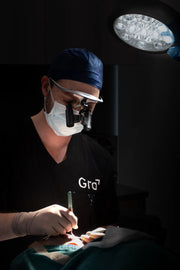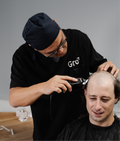It’s a common question: if you’ve had a hair transplant, can you still experience hair loss? While transplanted hair is typically long-lasting, it’s important to understand how genetic hair loss works—and how to maintain results over time.
Understanding Hair Growth and Loss
What causes hair loss?
Most men and some women experience hereditary hair loss, also called androgenetic alopecia. It’s linked to a hormone called dihydrotestosterone (DHT), which gradually causes hair follicles on certain areas of the scalp to shrink.
This process shortens the hair growth cycle and eventually stops the follicle from producing new hair. The pattern and progression of loss vary between individuals.
The hair growth cycle explained
- Anagen: The growth phase. Hair actively grows for 2–6 years.
- Catagen: The transition phase. Lasts 2–3 weeks.
- Telogen: The resting and shedding phase. Lasts around 3 months.
In those with hereditary hair loss, DHT accelerates the shift from anagen to telogen, leading to thinner, shorter hairs over time.
What Happens in a Hair Transplant?
Hair transplants move follicles from DHT-resistant areas—usually the back and sides of the scalp—to thinning or balding areas. These follicles retain their resistance to DHT after being relocated.
At Gro, procedures are performed using our refined method based on the FUE (Follicular Unit Extraction) technique. Every step is carried out by a doctor or directly overseen by a doctor. Our method aims to protect the follicle during extraction and control the angle, direction, and placement of each hair to suit the natural flow and density of your hair.
To learn more about our method, visit our hair transplant overview page.
Can Hair Loss Still Occur After a Transplant?
The transplanted follicles are expected to grow for many years—often for life. However, it’s still possible to lose native, non-transplanted hairs in areas not treated by the procedure.
For example, someone who had a transplant in their 20s to lower the hairline might still experience thinning at the crown in their 30s or 40s if that area is genetically prone to loss.
This is why ongoing management may be recommended.
What to Expect After the Procedure
Initial shedding is normal
In the first few weeks post-procedure, newly transplanted hairs may shed. This is a normal part of the healing and regrowth process and typically resolves as follicles enter a new growth phase.
Ongoing care and support
After a procedure, your doctor may recommend prescription hair care to help maintain the rest of your existing hair. These treatments are designed to support long-term maintenance and minimise further thinning.
To explore your options, you can book a free consultation with one of our Hair Growth Advisors.
Prescription Hair Care After a Transplant
There are approved prescription options in Australia that can support hair retention. These typically work by either:
- Supporting blood flow to the scalp, helping to maintain follicles in the growth phase
- Reducing the impact of DHT on hair follicles
To learn more about medical options, visit our Prescription Hair Care page.
Need Personalised Advice?
Gro Clinics offers in-person consultations in:
You can also access prescription options through a secure telehealth platform via our Online Clinic.



















